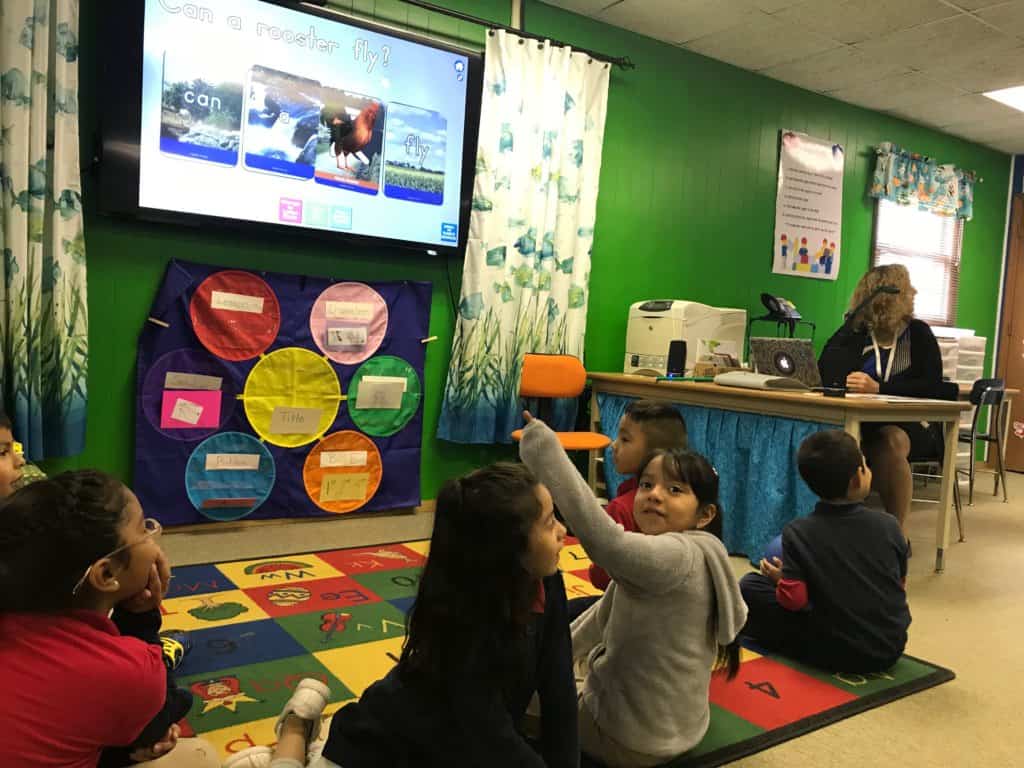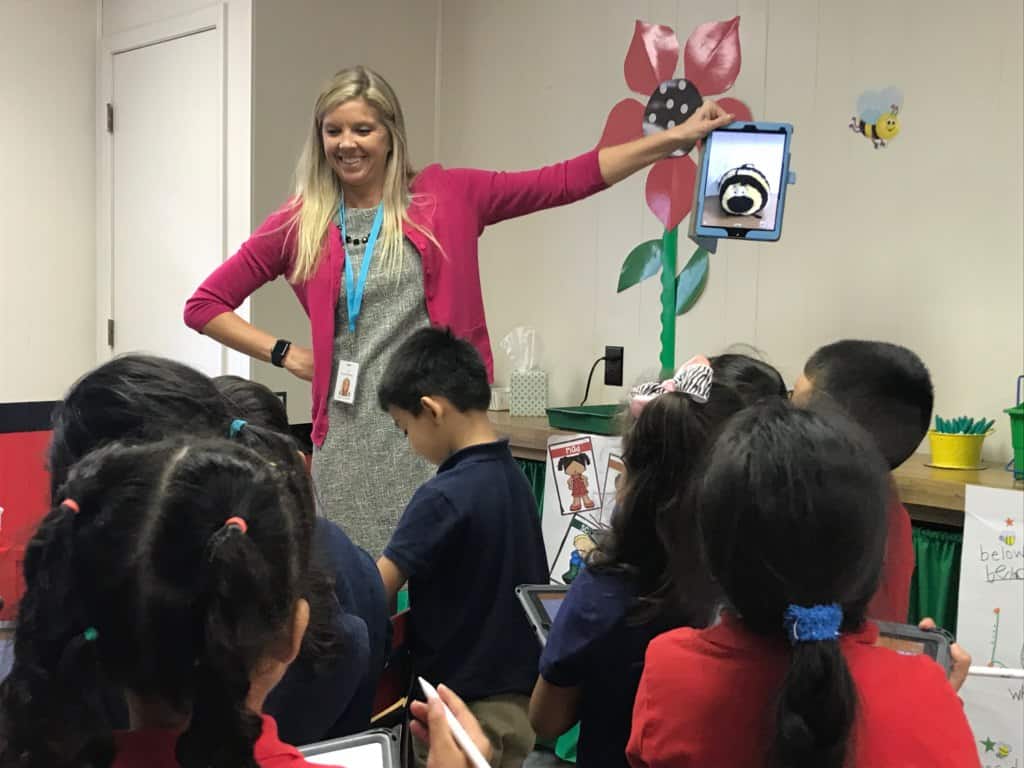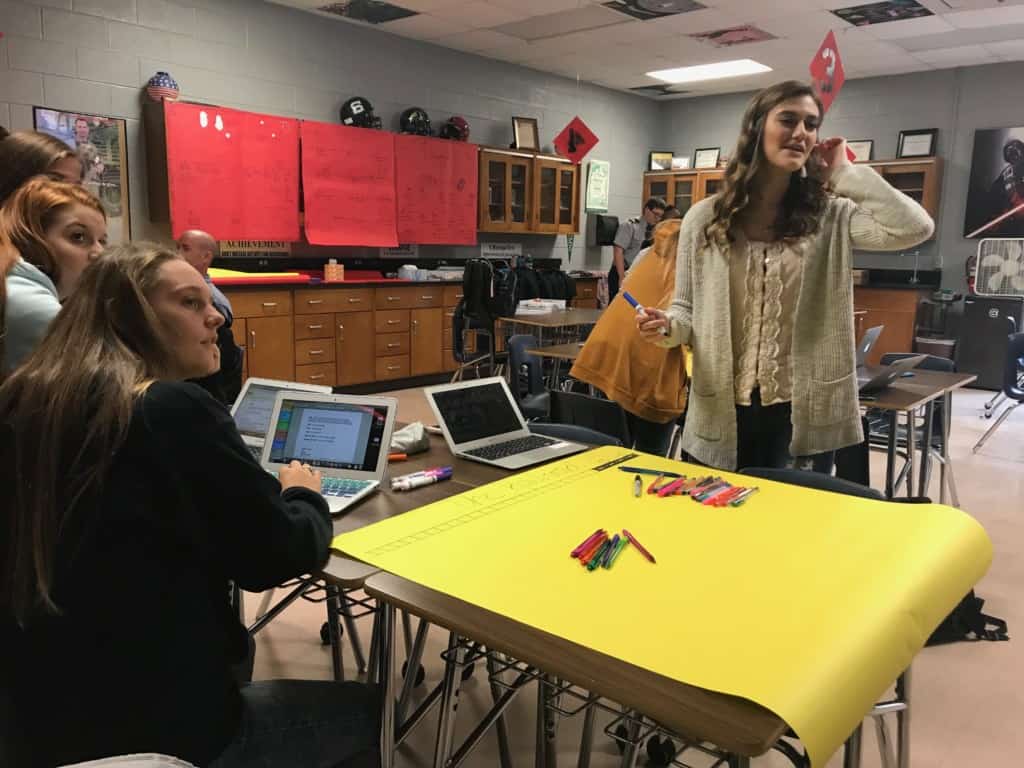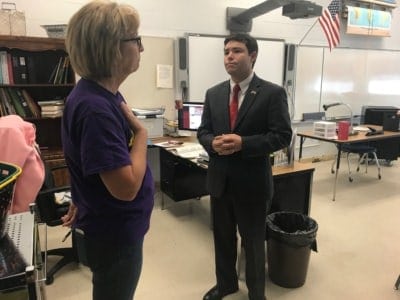None of the students in Katie Gardner’s kindergarten class are in their seats. They’re not supposed to be.
They are following their Knollwood Elementary School teacher around the room, searching for clues. When they find one, it corresponds with a letter that a talking bee is repeating on Gardner’s iPad. The students listen intently, then turn to their own iPads and, using the Pages software, write the letter they hear with their stylus.
The clues and letters correspond to a story and, later, the children all sit on the floor, side-by-side, with paper and pencils to write their thoughts, using prompts that appear on the flat-screen at the front of the classroom.
It’s all part of the blended digital and traditional learning taking place in Rowan-Salisbury Schools.
“How do we teach in the world they’re going to be working in,” Rowan-Salisbury Superintendent Lynn Moody said. “That’s what we’re doing.”

Educators from around the state are getting a first-hand look at how digital learning is blended with traditional methods in Rowan-Salisbury during the 2018 Digital Learning Research Symposium, presented by North Carolina Independent Colleges and Universities and the Rowan-Salisbury School System.
The symposium gathers college and university faculty, as well as superintendents and officials from North Carolina’s public school system, to discuss digital learning and how to integrate it in class.
“The reality is that kids today know more about the digital environment than do the teachers,” said state representative Craig Horn, R-Union, speaking to participants about the importance of smartly integrating digital learning. “The teachers know more about the digital environment and how to use it than do the teachers teaching the teachers to be teachers. So we have the paradigm all upside down and backwards. We need to turn it over and turn it around.”
On Thursday, that’s what educators at the symposium discussed, comparing notes on what they’ve experienced, seen, and learned.
A few months ago, Horn said, North Carolina became the only state in the nation to offer broadband at every public school — reaching more than 1.5 million kids across 3,000-plus schools. In Rowan-Salisbury, the school system has taken that a step further, ensuring every child in the district has a device to use as a tool in their learning.
Kindergartners, first-, and second-graders have iPads assigned to them for use in schools. From third grade throughout middle school, students are given iPads to take home and use for the school year. For high school students, it’s a MacBook Air laptop.
With every student armed with a device and internet access, the possibilities have broadened for Rowan-Salisbury teachers, who are now developing and publishing their own content for student consumption. Text books have been replaced by tech books and teacher original content.

While integral in many lessons, the devices are not driving lesson planning, though.
“It’s a tool,” said Kelly Withers, principal at South Rowan High School. “We never started class before and said, ‘I want to use crayons and markers today, now what am I going to teach.’ We taught class and used the crayons and markers as tools. This is just a tool.”
A tool that the students are already familiar with and eager to use.
“I think we can all agree that today’s students are not like us,” Horn said. “They’re a different breed of cat. They’re not just digital natives, they’re digital omnivores. They consume everything. And they seem to do it in the flash of an eye.”
In Josh Mullis’s social studies class, students aren’t sitting in any noticeable orderly fashion. Some are at their desks, turned sideways in their chairs. Others are sitting on their desks. Halsey’s “Bad at Love” is playing over a speaker in the classroom. On the screen at the front of the classroom appears to be a game of Pac Man.
A passerby at South Rowan could confuse the scene for a mid-day hang out. But they would be very wrong. The students are each in front of their own laptop, focused on their “game” and encouraging their neighbors. The song is a timer; when it ends, the game is over. And the “game” is no ordinary arcade break — it’s a Pac Man quiz testing students’ knowledge of World War I history.
The students are comfortable. They are smiling. They are engaged.
When the game is over, before he will reveal the winner, Mullis — named teacher of the year at South Rowan — challenges his students to write one fact about World War I that everyone should know. The entire class dashes to the white board up front and each student makes their contribution. Mullis then challenges them to work together as a class and write numbers next to each student’s contribution sequencing the events.

Promoting teamwork and collaboration is a hallmark of education at South Rowan. The moment also serves as a reminder that digital tools are not meant to replace traditional ones nor promote zoning out before a screen.
Initially, when the idea of a digital environment was introduced to the district in 2014, there was concern from some parents who worried about their children and additional screen time. But district officials invited concerned parents into the schools to see what teachers were doing and speak to their students about what they were learning.
“When people get really concerned about screen time, it’s when the kids are sitting there like a zombie,” Moody said. “You can see, here, they’re interactive with the screen time. It’s also short periods of time.”
Neither in Gardner’s nor Mullis’s classrooms would you find students sitting motionless in front of screens, with that zombie look in their eyes. The screen time is purposeful, reinforcing newly learned material. It is limited. And it is integrated with both motion (searching the room for clues in Gardner’s class and dashing to the white board in Mullis’s) and traditional media (pencils and papers, markers and white boards).
And, for the students, it seems only natural that technology be integrated into their learning, mirroring their digital lives outside of school rather than contradicting it.
“It just makes things easier,” said Gage Teal, a tenth-grader at South Rowan. “It’s what we’re used to.”



